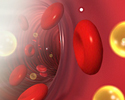Cholesterol and lifestyle
Hyperlipidemia - cholesterol and lifestyle; CAD - cholesterol and lifestyle; Coronary artery disease - cholesterol and lifestyle; Heart disease - cholesterol and lifestyle; Prevention - cholesterol and lifestyle; Cardiovascular disease - cholesterol and lifestyle; Peripheral artery disease - cholesterol and lifestyle; Stroke - cholesterol and lifestyle; Atherosclerosis - cholesterol and lifestyle
Your body needs cholesterol to work well. But cholesterol levels that are too high can harm you.
In the US, blood cholesterol is most often measured in milligrams per deciliter (mg/dL). Extra cholesterol in your blood builds up inside the walls of your blood vessels. This buildup is called plaque, or atherosclerosis. Plaque reduces or stops blood flow. This can cause a:
- Heart attack
- Stroke
- Serious heart or blood vessel disease
Your Cholesterol Numbers
All men should have their blood cholesterol levels tested every 5 years, starting at age 35 years. All women should do the same, starting at age 45 years. Many adults should have their blood cholesterol levels tested at a younger age, possibly as early as age 20 years, if they have risk factors for heart disease. Children with risk factors for heart disease should also have their blood cholesterol levels checked. Some expert groups recommend cholesterol testing for all children ages 9 to 11 and again between ages 17 and 21. Have your cholesterol checked more often (probably every year) if you have:
- Diabetes
- Heart disease
- Blood flow problems to your feet or legs
- A history of stroke
A blood cholesterol test measures the level of total cholesterol. This includes HDL (good) cholesterol and LDL (bad) cholesterol.
Your LDL level is what health care providers watch most closely. You want it to be low. If it gets too high, you will need to treat it.
Treatment includes:
- Eating a healthy diet
- Losing weight (if you are overweight)
- Exercising
You may also need medicine to lower your cholesterol.
You want your HDL cholesterol to be high. Exercise can help raise it, but only a small amount.
Eating Right
It is important to eat right, keep a healthy weight, and exercise, even if:
- You do not have heart disease or diabetes.
- Your cholesterol levels are in the normal range.
These healthy habits may help prevent future heart attacks and other health problems.
Eat foods that are low in fat. These include whole grains, fruits, and vegetables. Using low-fat toppings, sauces, and dressings will help.
Look at food labels. Avoid foods that are high in saturated fat. Eating too much of this type of fat can lead to heart disease.
- Choose lean protein foods, such as soy, fish, skinless chicken, very lean meat, and fat-free or 1% dairy products.
- Look for the words "hydrogenated", "partially hydrogenated", and "trans fats" on food labels. Do not eat foods with these words in the ingredients lists.
- Limit how much fried food you eat.
- Limit how many prepared baked goods (for example, donuts, cookies, and crackers) you eat. They may contain a lot of fats that are not healthy.
- Eat fewer egg yolks, hard cheeses, whole milk, cream, and ice cream.
- Eat less fatty meat and smaller portions of meat, in general.
- Use healthy ways to cook fish, chicken, and lean meats, such as broiling, grilling, poaching, and baking.
Eat foods that are high in fiber. Good fibers to eat are oats, bran, split peas and lentils, beans (kidney, black, and navy beans), some cereals, and brown rice.
Learn how to shop for, and cook, foods that are healthy for your heart. Learn how to read food labels to choose healthy foods. Stay away from fast foods, where healthy choices can be hard to find.
Get plenty of exercise. And talk with your provider about what kinds of exercises are best for you.
References
American Diabetes Association. 10. Cardiovascular disease and risk management: standards of medical care in diabetes-2022. Diabetes Care. 2022; 45(Suppl 1):S144-S174. PMID: 34964815 pubmed.ncbi.nlm.nih.gov/34964815/.
Arnett DK, Blumenthal RS, Albert MA, Buroker AB, et al. 2019 ACC/AHA Guideline on the primary prevention of cardiovascular disease: executive summary: a report of the American College of Cardiology/American Heart Association Task Force on Clinical Practice Guidelines. J Am Coll Cardiol. 2019;74(10):1376-1414. PMID: 30894319 pubmed.ncbi.nlm.nih.gov/30894319/.
Eckel RH, Jakicic JM, Ard JD, et al. 2013 AHA/ACC Guideline on lifestyle management to reduce cardiovascular risk: a report of the American College of Cardiology/American Heart Association Task Force on practice guidelines. J Am Coll Cardiol. 2014;63(25 Pt B):2960-2984. PMID: 24239922 pubmed.ncbi.nlm.nih.gov/24239922/.
Grundy SM, Stone NJ, Bailey AL, et al. 2018 AHA/ACC/AACVPR/AAPA/ABC/ACPM/ADA/AGS/APhA/ASPC/NLA/PCNA Guideline on the management of blood cholesterol: a report of the American College of Cardiology/American Heart Association Task Force on Clinical Practice Guidelines. J Am Coll Cardiol. 2019;73(24):e285-e350. PMID: 30423393 pubmed.ncbi.nlm.nih.gov/30423393/.
Hensrud DD, Heimburger DC, eds. Nutrition's interface with health and disease. In: Goldman L, Schafer AI, eds. Goldman-Cecil Medicine. 26th ed. Philadelphia, PA: Elsevier; 2020:chap 202.
Mozaffarian D. Nutrition and cardiovascular and metabolic diseases. In: Libby P, Bonow RO, Mann DL, Tomaselli GF, Bhatt DL, Solomon SD, eds. Braunwald's Heart Disease: A Textbook of Cardiovascular Medicine. 12th ed. Philadelphia, PA: Elsevier; 2022:chap 29.
Review Date: 7/30/2022
Reviewed By: Stefania Manetti, RD/N, CDCES, RYT200, My Vita Sana LLC - Nourish and heal through food, San Jose, CA. Review provided by VeriMed Healthcare Network. Also reviewed by David C. Dugdale, MD, Medical Director, Brenda Conaway, Editorial Director, and the A.D.A.M. Editorial team.








